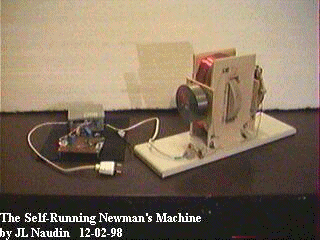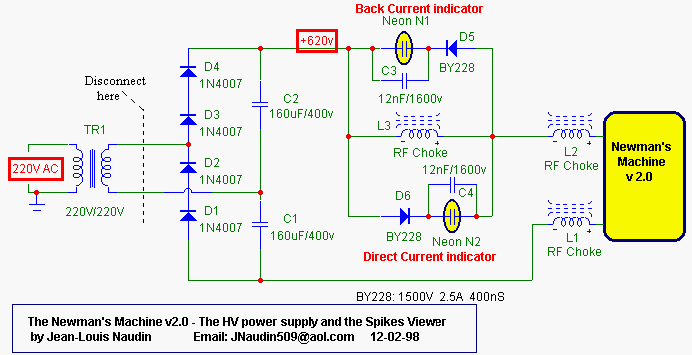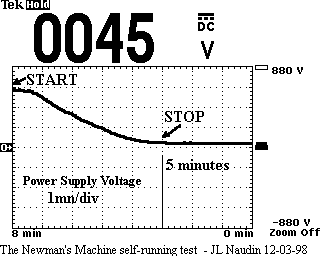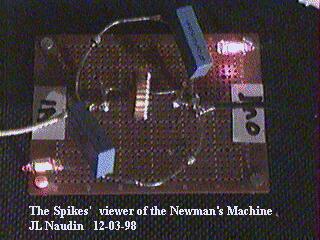

The Newman's Energy Machine
Self-Running Demonstration
created on 12-02-98 - JLN Labs - last update on 12-15-98
12-02-98 - Demonstration of the Self-Running Newman's Machine.
I am glad to present you, a video demonstration with my personnal comments about a the Newman's Machine v2.0 working in self running mode. After that the power supply was disconnected the machine is able to run itself for few minutes at 330 RPM while its generates mechanical and electrical power. This is the first step, I need to increase this effect for a real self-sustained and durable self-running....
If you have already installed the ReaVideo player (tm), fasten your seat belts and watch the self-running demo video of the Newman's Machine v2.0.
See the Self-Running ONLINE video demo with ENGLISH subtitles and addtional comments,
See the Self-Running ONLINE video demo with GERMAN subtitles and addtional comments,
See the Self-Running ONLINE video demo with FRENCH subtitles and addtional comments,
( if you don't have the RealPlayer 5.0, you may download it freely at : http://www.real.com/products/player/ )
Additional comments about the demonstration ( 12-03-98 ):
The Newman's Machine speed was about 330RPM, without mechanical load on the shaft, the electrical power input needed was about 210 mW. This is the power needed for overcoming the mechanical frictions and the Joule's losses. This has been mesured during the previous test report ( on 11-22-98 ).
You will find below, the power supply diagram :


The self-running time during the demo was
about 5
minutes. You may
notice that the power supply uses two 160uF capacitors in series,
thus this give a 80uF capacitance at 620 Volts. This give a
stored energy in the capacitors (C1,C2): W = 0.5 * 80e-6 * ( 620
^ 2 ) = 15.3 Joules.
When I have disconnected the 220 Vac input, the Newman's Machine
had only 15.3 Joules of energy for running itself. I have
previously measured that, the power needed for overcoming the
mechanical losses and Joules losses was 210 mW, with the neon
bulbs this give about 220mW of electrical power.
So, this give a calculated working time
of T= W / P = 15.3 / 0.22 = 70
seconds. This mean that after 70 seconds
the capacitors voltage has dropped to 0 Volt ( this is not the
case in this test). The diagram below shows the record of the
voltage with respect to time of the power supply during the
self-running test.

You may notice that the Newman's Machines
has stopped at 45 volts and after 5
minutes of self-running.
If there is no voltage in the power supply
and that the Newman's machine has been previously set at the same
rotation speed, the time needed to stop completly was 30 seconds.

For more informations about the Spikes Viewer (click here)
You may see also: New Power measurements: the self-running effect, now explained ? (12-14-98)
![]() Email
: JNaudin509@aol.com
Email
: JNaudin509@aol.com
Return to the Newman's Machine Main page